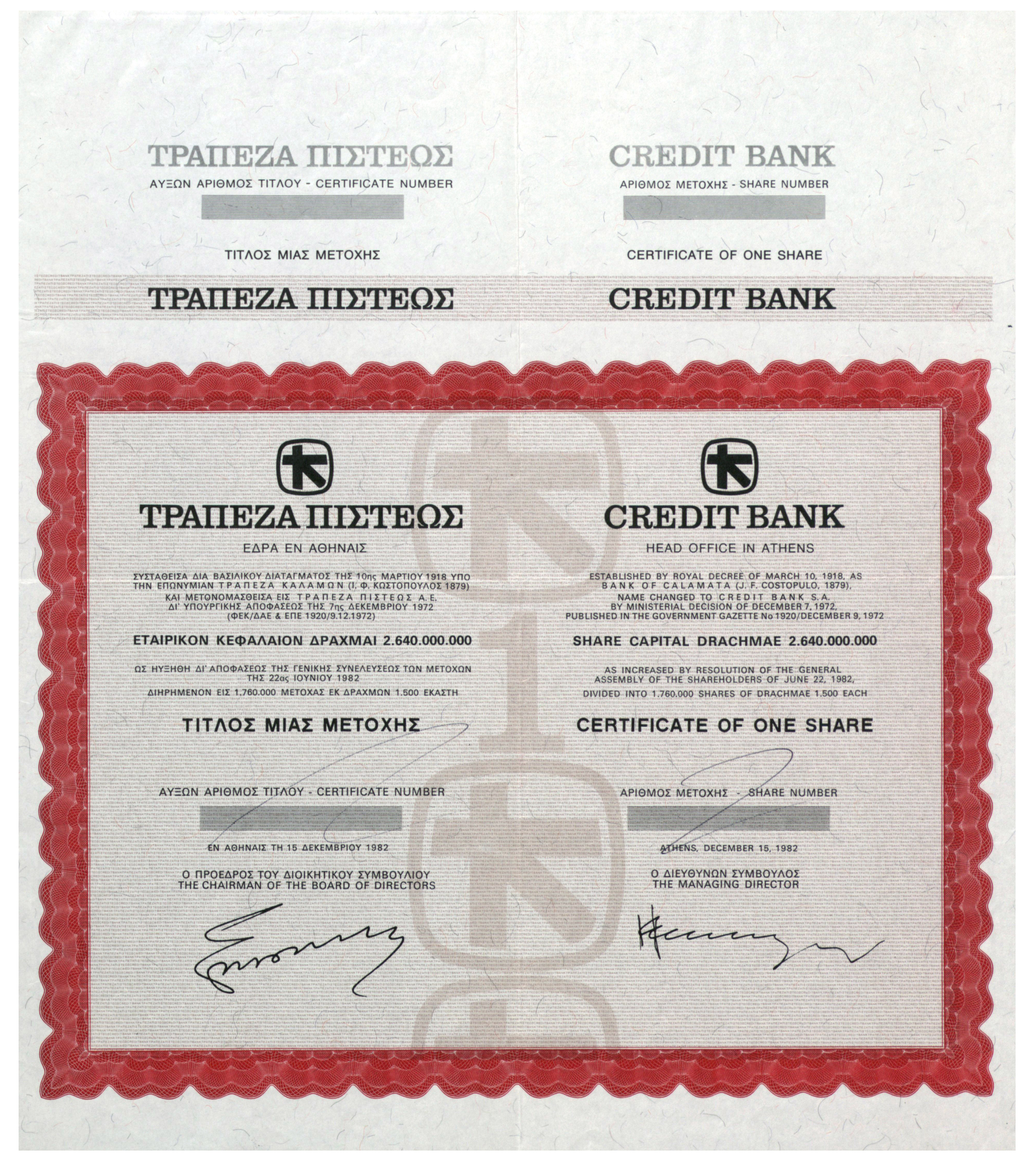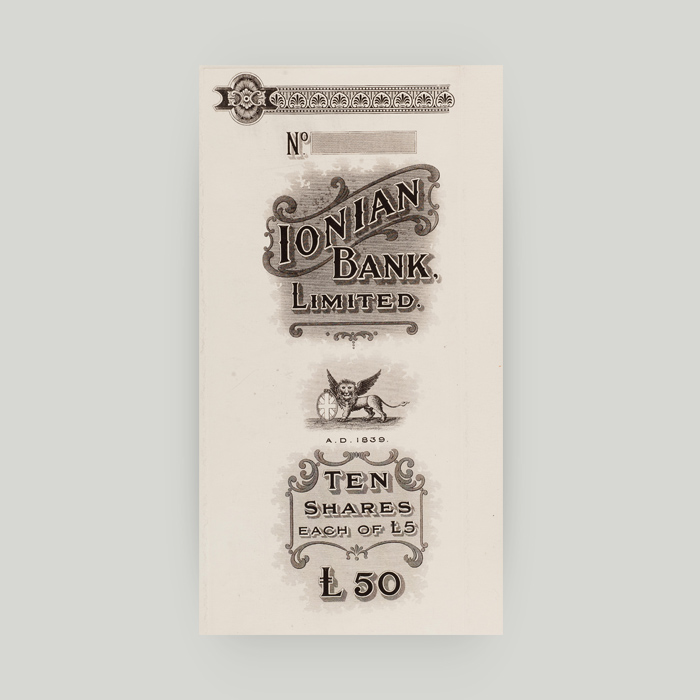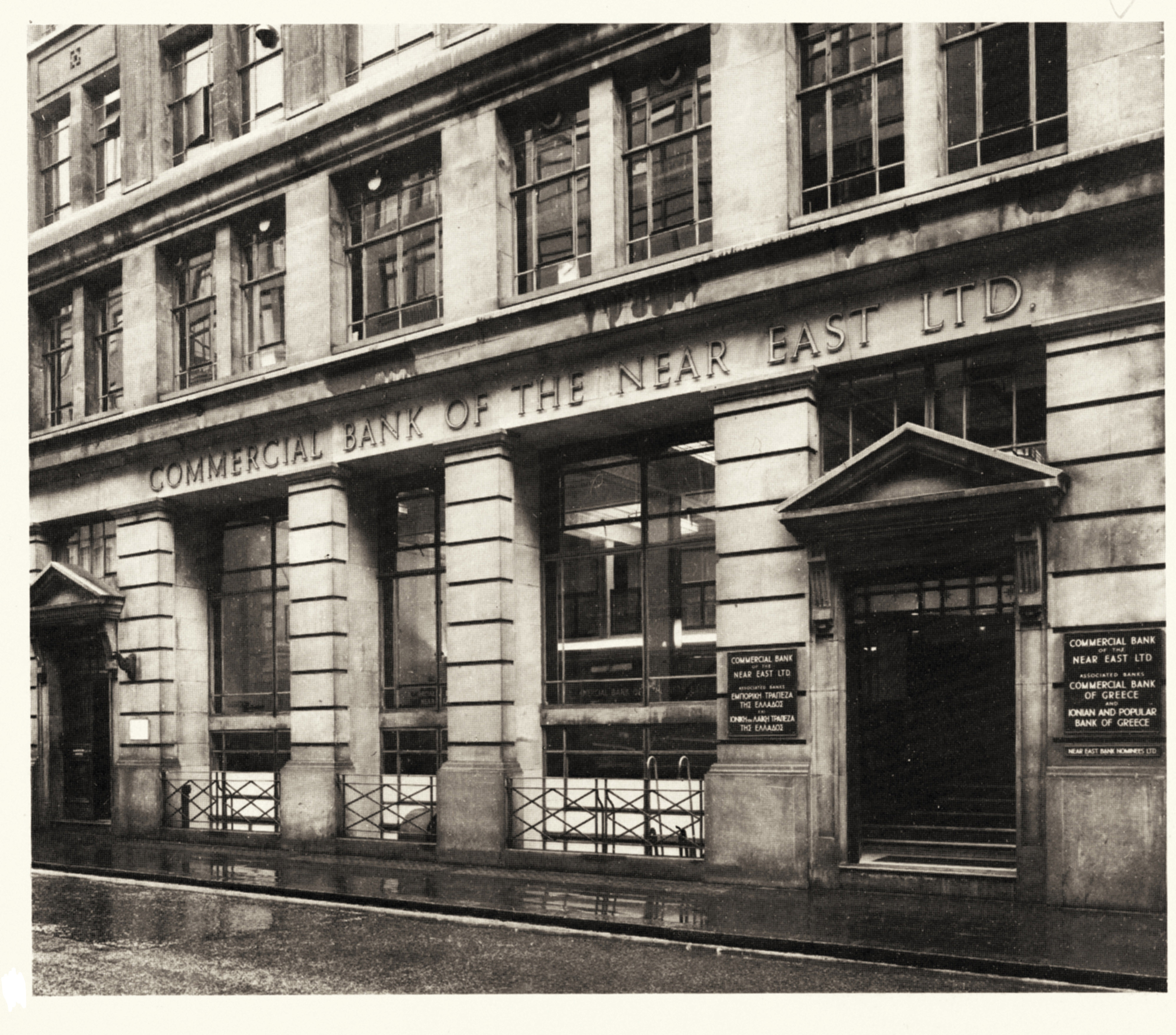Brief history of Credit Bank
The modernisation of Credit Bank began in 1972. The bank created a new corporate identity and started to benefit from the loosening of the restrictions governing the Greek banking system until then. By the end of the 1980s, its group of undertakings covered almost the entirety of products and services in the financial sector. The Credit Bank 1-share stock certificate from 1982 belongs to the Alpha Bank debt securities and shares collection covering the years from 1972 to 1993.
Credit Bank paper stock certificate to the value of 1,500 drachmas, issued in 1982.
The bank logo appears at the top part. The logo was inspired from the type on the reverse of the silver stater of Aegina (480-456 BCE), the first city-state in the Greek world to mint its own coins.
The text appearing in the main frame includes the bank’s year of establishment, the share capital, the number of shares and the nominal price of each share, in Greek and English.
The bank logo also appears as a watermark along with the number of shares in an off-beige background.
A red geometric pattern makes up the border wrapping the text.
Looking to the future
From 1972 to 1993 Alpha Bank was still named Credit Bank. In 1973 Credit Bank embarked on a long-term programme to modernise its operations under the direction of Yannis Costopoulos.
The bank adopted a new corporate identity that was promoted and advertised in the context of an innovative, integrated communication strategy launched for the first time in Greece. This strategy aimed at outlining the bank’s profile through the selected symbols and colours.
At the same time, a comprehensive administrative reform plan was set in motion that would address the new conditions and priorities.
A period of transition
Credit Bank transitioned from a human-centric model to a managerial approach.
In 1974, the bank network consisted of 48 branches, 18 of which operated in Athens, Piraeus (the port of Athens) and Thessaloniki (the second largest city in the country). The other 30 branches were distributed among the largest Greek cities.
The first steps towards a group
In the late 1980s, the bank started launching business initiatives to establish subsidiaries.
In 1981 it founded the subsidiary “Alpha SA Organisation and Computerisation Research Consultants”. This was the first time the “Alpha” component was used to name one of its subsidiaries. In early 1989 the company name was permanently changed to Alpha Financial Leasing SA. It was the first financial leasing company to operate in Greece and was established shortly after the very concept of financial leasing had appeared.
Credit Bank went on to further expand its group operations:
- In 1982 IFKOS, an undertaking already owned by the bank, was renamed Urban Real Estate.
- In 1983 portfolio investment company Credit Investments was established.
- In 1984 DELTA Information Technology was established in the context of a major effort to develop the bank’s IT infrastructure.
- In 1985 life insurance company Generali Life was established.
Loosening of the banking system restrictions
In the late 1980s a series of actions led to the loosening of the restrictions governing the Greek banking system. And Credit Bank was definitely ready to make the most of the new circumstances. The bank started to establish subsidiaries in industries where it anticipated competition:
- Finance – Alpha Finance (1988) and Alpha Securities (1989), the first company to enter the Athens Stock Exchange.
- Mutual Funds – Alpha Mutual Funds Management (1989).
- Venture capital – 2 venture capital funds (1990).
Pioneering innovation
Throughout the 1980s, Credit Bank pioneered the launch of products and services that were innovative for the Greek market:
- Cashcard Visa, the first bankcard/credit card in Greece that functioned as both a credit card and a cash card to be used for deposits and withdrawals.
- Alphaphone, the first ever home banking application in Greece, which provided banking services via telephone.
- Alphalink, the first card payment and automatic transaction authorisation system operating through the bank’s devices.
From the early 1990s onwards, Credit Bank’s profitability was well above the Greek banks’ average. This allowed the company to stay on a growth path and significantly increase its market share within a matter of a few years.
In the early 1990s the bank’s network consisted of 135 branches. Many of them were located in Athens and Piraeus.
An outward-looking approach
Gradually, Credit Bank started its expansion abroad.
In 1988 it opened a representative office in London. A few years later, in 1992, it founded Bucharest Bank, present-day Alpha Bank Romania.
In 1994 Credit Bank first announced it would operate internationally as “Alpha Credit Bank”. Next, the local company name was also changed to the Greek version of “Alpha Credit Bank”.
Credit Bank’s collection of debt securities
The Credit Bank 1-share stock certificate was issued in 1982 and belongs to Alpha Bank’s debt securities and shares collection.
Items in the collection date from 1972 to 1993.
Credit Bank in our publications
More information on Credit Bank is available in With Wisdom and Vision: ALPHA BANK, 19th – 21st Century, academic advisor: Kostas Kostis. The publication narrates the history of Alpha Bank, from founder J. F. Costopoulos’ first commercial ventures in the 19th century through to the present day. It also includes a wealth of unpublished photographic material, mainly from the Alpha Bank Historical Archives.
Buy the publication With Wisdom and Vision: ALPHA BANK, 19th – 21st Century on the Alpha Bank e-shop.
The Alpha Bank Historical Archives are not open to the public.
Research visits can be organised upon request.
Contact us to request a visit.






